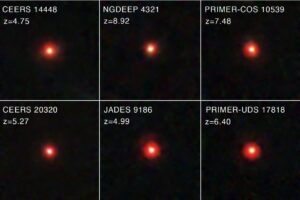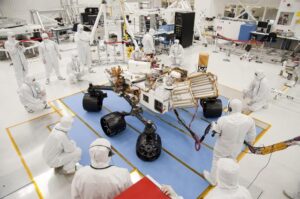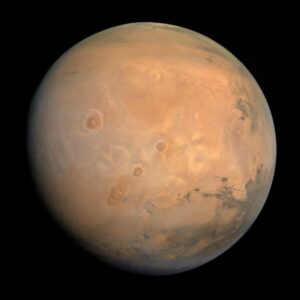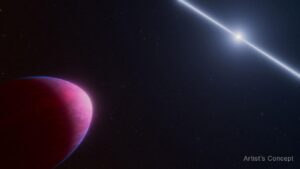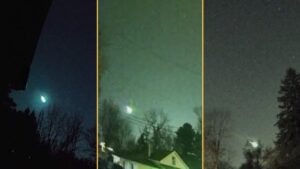Asteroid hunter Jacqueline Fazekas started the evening of Sept. 4, 2024, much like she spends half of every lunar month: seated in front of the computer monitor at Mt. Lemmon Observatory near Tucson, Arizona. She cycled the telescope between different sections of the sky, looking for any dots in motion.
Fazekas had noticed moving objects before and sent them to the Minor Planet Center for follow-up, as per protocol. The faint smudge she noticed on Sept. 4 seemed to shift position across four exposures, so she sent its coordinates to the Minor Planet Center and continued her sky scans.
In the past, objects Fazekas submitted occasionally came back with a NASA hazard assessment estimating a 0.01% or 0.02% chance of hitting the Earth. This time was different. When NASA’s program released an alert for her little moving dot, the collision probability was 25%.
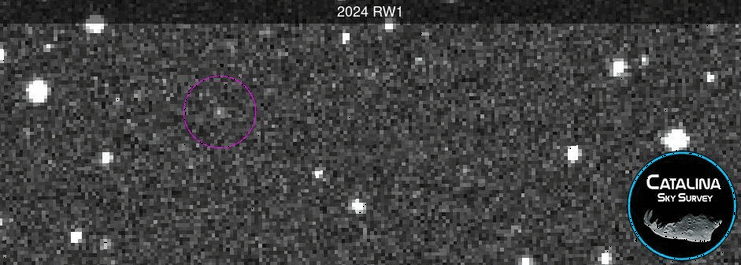
The exposures in which Jacqueline Fazekas identified asteroid 2024 RW1. Photo: Jacqueline Fazekas/Carson Fuls/Catalina Sky Survey
Observers around the world jumped to observe the asteroid, christened 2024 RW1. By midnight in Arizona, new data increased the probability of impact to 100%. As night crept into morning, planetary scientists had narrowed the location of impact to the island of Luzon in the Philippines, and the time to just after noon.
They identified something else as well. Though 2024 RW1 might be shocking in its sudden appearance, it wasn’t dangerous. Only one meter in diameter, it would probably burn up on entry. Sure enough, at 12:40 pm local time, that’s exactly what it did in the sky over Luzon, in the Philippines.

Asteroid 2024 RW1 burns up in the sky above Luzon in the Philippines. Photo: Alan Madelar
The way of the dinosaurs

The Chicxulub Crater on the Yucatan Peninsula maintains the geographic memory of the Cretaceous-Paleogene Extinction Event. Photo: UT Austin/Google Maps
Around 66 million years ago, an asteroid the size of San Francisco slammed into the warm, shallow waters off the coast of what is now southern Mexico. The impact melted the crust into magma and threw it high into the air. Beads of glass rained down across North America, and that was only the beginning of the world’s problems. Tsunamis spread across the ocean and drowned the land while subterranean fires cast the Earth into ash-shrouded darkness. Three-quarters of fauna and flora went extinct.
This was the Creteaceous-Paleogene extinction event, the doorway between the reign of the dinosaurs and the reign of mammals. The Earth bears scars of this trauma. A thin band of iridium-rich rock sits sandwiched between the sedimentary remnants of the Cretaceous period, the final age of the dinosaurs, and the Paleogene Period, when mammals began to emerge as the dominant large animals.
When physicist Luis Alvarez and his team discovered the Cretaceous-Paleogene iridium boundary in 1980, their conclusion that an iridium-rich asteroid had hit the Earth and caused the extinction of the dinosaurs was far from certain. It wasn’t until 1991 that evidence of the buried Chicxulub crater in southern Mexico catapulted the asteroid theory from the geological fringes to public school curricula.
You, me, and the apocalypse
The discoveries of the Cretaceous-Paleogene iridium boundary and the Chicxulub crater awoke scientists to the threat of impact events, but not politicians. With perfect timing, comet Shoemaker-Levy 9 arrived.
Its discoverers — Carolyn Shoemaker, Eugene Shoemaker, and David Levy — immediately knew it was strange. In a note to the International Astronomical Union summarizing their observations, astronomer Brian Marsden wrote that the comet was “most unusual in that it appeared as a dense, linear bar about one inch long and oriented roughly east-west.” And almost as an afterthought: “The comet is located some four degrees from Jupiter, and the motion suggests that it may be near Jupiter’s distance.”

The evaporating fragments of comet Shoemaker-Levy 9 on their approach to Jupiter. Photo: NASA/ESA/H. Weaver/E. Smith (STScI)
In fact, it wasn’t merely near Jupiter’s distance, but on a collision course. By the time the Shoemakers and Levy found it, the force of Jupiter’s gravity had shredded it into twenty-one pieces, many larger than a kilometer across.
Astronomers watched with bated breath, hoping to see not only how violently the impact would affect Jupiter, but also clouds of ejecta that could give them a glimpse of inner atmospheric chemistry. They got everything they wanted and more. Meanwhile, the public got its first vision of what impactors could do to planets.
The scars of Shoemaker-Levy 9 outshone the Great Red Spot, Jupiter’s famous cyclone region. Alongside the freckled impact zones that remained visible for months, the gas giant’s atmosphere rocketed to 30,000°C, hotter than the temperature of its core. On Earth, governments around the world decided to pour a lot more money into Near Earth Object (NEO) detection.

Ejecta from the 1994 Shoemaker-Levy 0 impacts. Photo: H. Hammel/MIT/NASA
So how can humans tackle the awesome task of preventing mass extinction by asteroid? What does that work look like today, thirty years after the events that kick-started it? And what sort of person takes it on for a living?
Meet the asteroid hunters
This takes us back to people like Jacqueline Fazekas, the observer at the Catalina Sky Survey (CSS) who discovered asteroid 2024 RW1. Fazekas was only the ninth person to detect an asteroid before impact, and the first woman. Two years out of her undergraduate degree in astrophysics and space physics, her enthusiasm shines through when she describes her work. But it’s not just the observing she loves, she’s a regular tour guide at the Mt. Lemmon Sky Center, and is working towards a PhD in curriculum design and teaching.
“I want people to realize that anyone can do these things,” Fazekas says of her historic discovery.

Jacqueline Fazekas in front of her 2024 RW1 detection exposures. Photo: Jacqueline Fazekas
Anyone she inspires to get involved with NEO tracking will be joining a winning team. Of those nine asteroids detected before impact, over half hit in the 2020s, meaning our detection protocols are improving at breakneck speed.
That statistic is thanks to programs like CSS and its colleagues such as PanSTARRS in Hawaii, the Zwicky Transient Facility in California, and Tomo-e Gozen in Japan. Every night, observers around the world monitor scans like the ones in which Fazekas discovered 2024 RW1. Through their work, we now know the location and orbits of almost all massive, extinction-level asteroids. None of them are on a collision course.
The threat of mid-size asteroids
The asteroids that worry Carson Fuls, director of CSS, are medium-sized ones of about 120 meters across. These asteroids could destroy cities, but their size makes them hard to detect.
“There could be an object that we either don’t see because it comes from the direction of the Sun…or we see it and we only have a day or two to do anything, in which case [governments] would try to evacuate people,” Fuls said.
Fuls started at CSS as an observer like Fazekas. Over the years, he started working more on the engineering side, before deciding to pursue a Master’s degree in Planetary Science at the University of Arizona. Right as he was set to start his graduate studies, the then-director of CSS announced his retirement. Fuls turned in an application as his successor and got the job.
Now a second-year PhD student, he juggles running CSS with scientific research on asteroids. Many people in his department find the combination bemusing, but his eclectic mix of work extends into CSS too. As director, he sets the direction of one of the most successful planetary defense programs on Earth. This week, though, he’s trying to rent a porta-potty for observers while one of the sites is under renovation.
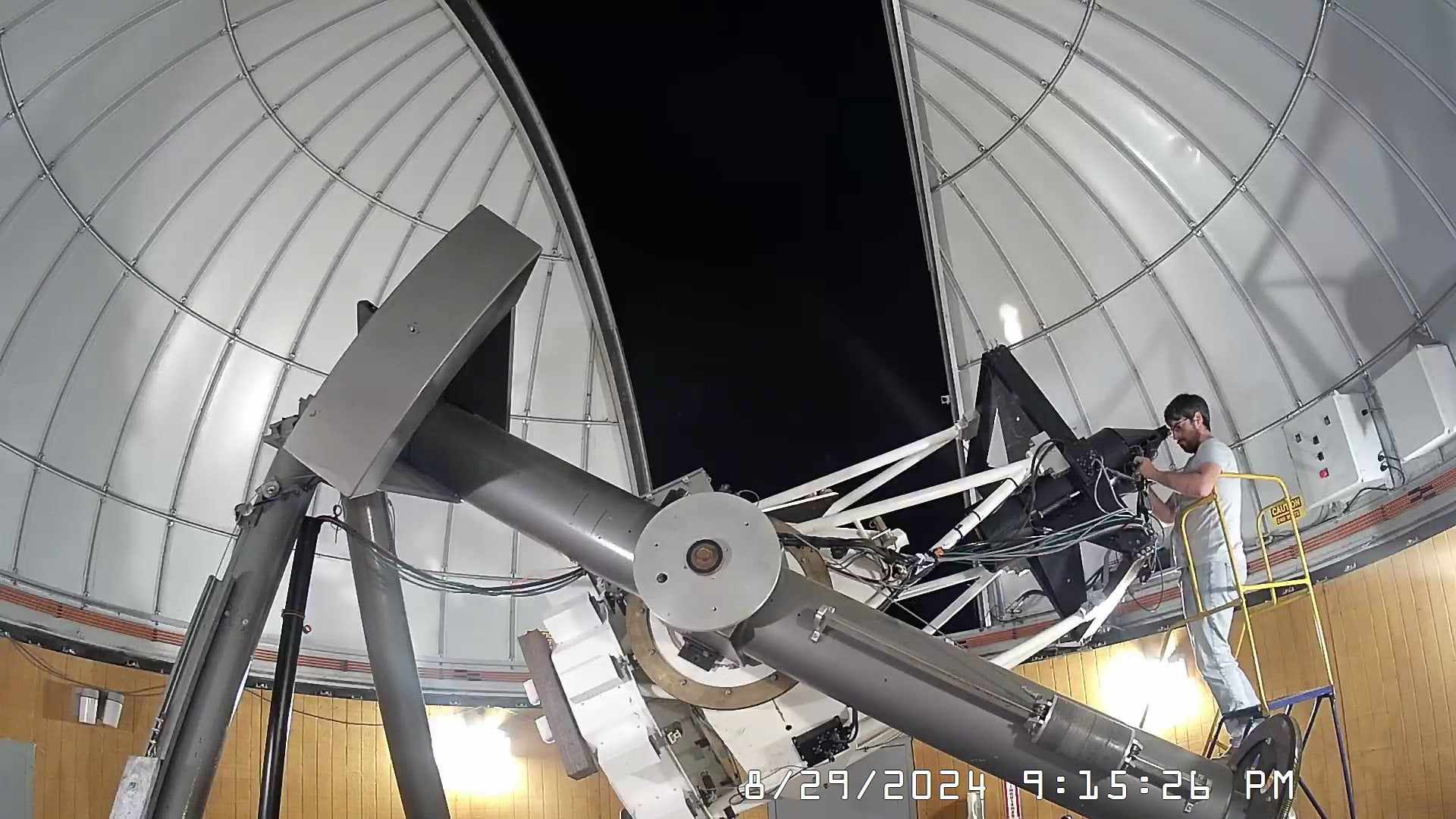
Carson Fuls at the Mt. Lemmon one-meter telescope. Photo: Carson Fuls
The biggest modern asteroid impact
The closest we’ve come to Fuls’ nightmare scenario was in 2013 when a 20m asteroid exploded in the sky above the Russian city of Chelyabinsk. The resultant shock wave hospitalized 112 people but, astoundingly, killed no one.
Russia has a thriving illegal industry of car accident fraud, and many people set up dashboard cameras to prove their innocence if they become victims. No one knew the Chelyabinsk meteor was coming, but everyone’s camera was rolling. That made the Chelyabinsk meteor one of the most well-recorded surprise astronomical events ever.
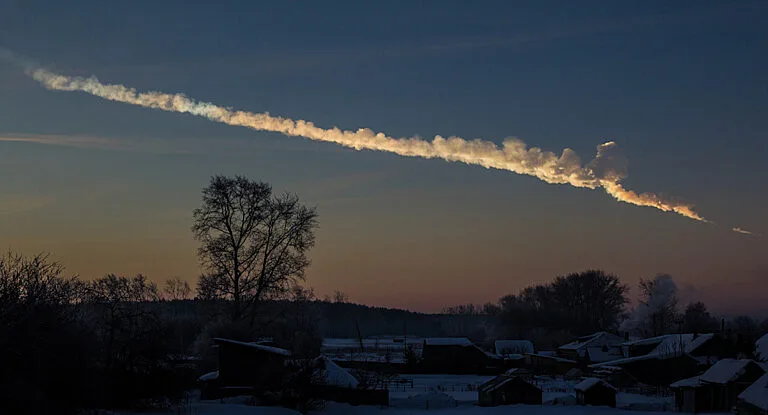
A vapor trail from the Chelyabinsk meteor. Photo: Alex Alishevskikh
Astronomers didn’t see the Chelyabinsk meteor beforehand because it arrived from the direction of the Sun. Asteroids don’t radiate optical light, so we can only see them if they reflect sunlight. The Chelyabinsk meteor was silhouetted, not highlighted.
Although its unexpected explosion was violent, it happened high up in the atmosphere, sheltering the city below from the worst of the blast. A 120m asteroid would have made it to the ground, wiping out Chelyabinsk.
The chances of such an event get slimmer every day. Fuls estimates astronomers have located about 50% of the asteroids of that size. He wants to push that statistic past 90%, which he thinks can happen soon.
A new generation of powerful telescopes will soon be coming online, in particular the Legacy Survey of Space and Time (LSST) and NEO Surveyor. Based in Chile and scheduled to start in 2025, LSST will increase the number of known asteroids by a factor of 10 to 100. NEO Surveyor, meanwhile, will sit in outer space and watch for asteroids coming from the Sun’s direction, filling in our last major blind spot. NASA forecasts NEO Surveyor’s launch for 2027.
Soccer balls and cement
Once Fazekas and her colleagues have found an asteroid, they hand it off to people like Eileen Ryan. Asteroid orbits are complicated and long-term collision predictions require long-term observations. It’s Ryan’s job to watch asteroids until she’s figured out where they’re going and what they might do.
Ryan was the only woman in her graduating class of Rutgers physics majors. She didn’t care. She wanted to study the solar system. After early research on planetary atmospheres, she began a PhD in the same asteroid mecca where Carson Fuls is currently a student: the Lunar and Planetary Lab at the University of Arizona. To supplement her classes, she signed on to help a researcher explore the effects of violent asteroid impact.
Her first assignment was simple: make a model asteroid. Ryan bought soccer balls, cut the tops off, and filled them with cement. Before long she was trekking to the vertical gun range at NASA Ames and firing her cement soccer balls at the ground in a vacuum tube. From there, she moved to computer simulations.
Stalking asteroids
In 2004, New Mexico Tech hired Ryan to build a 2.4m telescope at Magdalena Ridge Observatory. The build team consisted of four people. Ryan brought on her particle physicist husband, as well as a construction technician and an engineer.
At the time, there were no telescopes that could detect mid-size asteroids. When Ryan used hers to track an asteroid too faint for anyone else to observe, NASA agreed to fund the telescope’s upkeep.

Eileen Ryan at the Magdalena Ridge Observatory 2.4m telescope. Photo: Eileen Ryan
Now Ryan works in the middle ground of hazardous asteroid mitigation. She still runs lab impact experiments and computer simulations but also directs asteroid follow-up. Occasionally, asteroids bump into each other or other objects in the Solar System. Their orbit diverges. Once-harmless asteroids can enter a collision course overnight, and Ryan’s there to find out when this happens.
On Sept. 26, 2022, a dense object slammed into the asteroid Dimorphos at 6 kilometers per second. Ryan and her team at Magdalena Ridge Observatory were watching. But this wasn’t an ordinary orbital follow-up and the colliding object wasn’t another piece of space debris. It was a 600kg chunk of metal, and NASA had sent it.
The eye of a needle
Like a sized-up version of Eileen Ryan’s soccer ball impacts, the Double Asteroid Redirection Test, or DART, was an outer space lab experiment. The idea: If a murderous asteroid is hurtling towards us, can we nudge it out of the way with a rocket? And what would happen to it afterward?
The DART spacecraft targeted an asteroid orbiting another, much larger asteroid. This makes follow-up easier since a small change in motion from a rocket impact is more noticeable in a very short orbit than a long one around the Sun. Dimorphos, DART’s 270m target, orbits the much larger Didymos at 11km from Earth. But to even hit Dimorphos in the first place would take a Robin Hood shot. It occupies one-millionth of a degree in the night sky, the same size as an atom at arm’s length.
One cloudy afternoon in my senior year of undergraduate astrophysics studies, I and the rest of my class sat and watched Dimorphos jitter forward on the projector screen. As the DART spacecraft and its camera sped toward the asteroid, the image reloaded every second to show a view closer by 6km. We held our breath in those last moments. When the final image came through, only a sliver at the top showed the gravelly surface of the asteroid.
The rest of the image was red. The DART spacecraft had struck Dimorphos, destroying itself before it could transmit the rest of the data.
NASA had threaded the eye of a needle and hit an asteroid 11 million kilometers from home.

The iconic last image from NASA’s DART mission. Photo: NASA
Bullseye
Andy Rivkin, one of the DART investigation leads, pushed to stream the spacecraft’s approach live even though it might miss.
“It was much more powerful streaming it,” he says. Not only to take the general public along for the ride but also “to have the immediate results of people around the world with their telescopes seeing this crazy stuff happening.”
Sure enough, Dimorphos brightened like a strobe right after DART hit it. Its shape changed, flattened like a piece of clay flung at a wall. And most importantly, teams including Ryan’s confirmed that its orbit around Didymos is now 33 minutes and 15 seconds shorter.
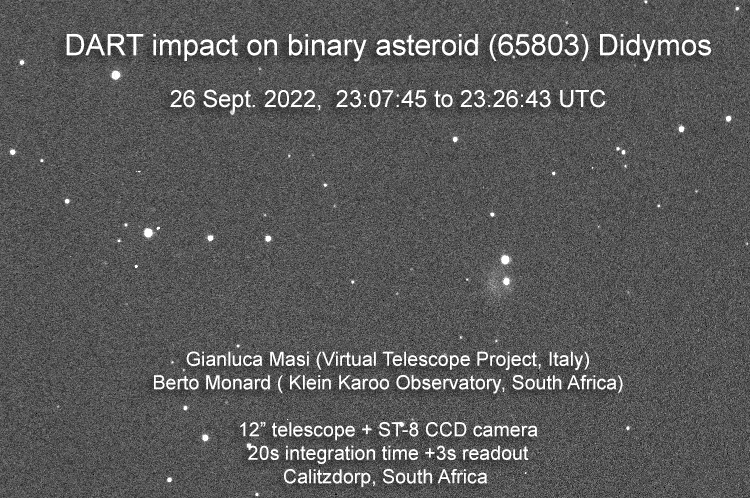
Observations of Dimorphos immediately after impact by DART. Photo: Virtual Telescope Project/Klein Karoo Observatory
While Rivkin’s days used to be devoted to DART, including writing its official song, he now has a new baby: the European Space Agency’s mission Hera. Set to launch in October 2024, Hera will head straight to Dimorphos to collect close-up data on its new orbit. This data will shape our playbook on how to redirect a potential asteroid away from the Earth.
Don’t panic
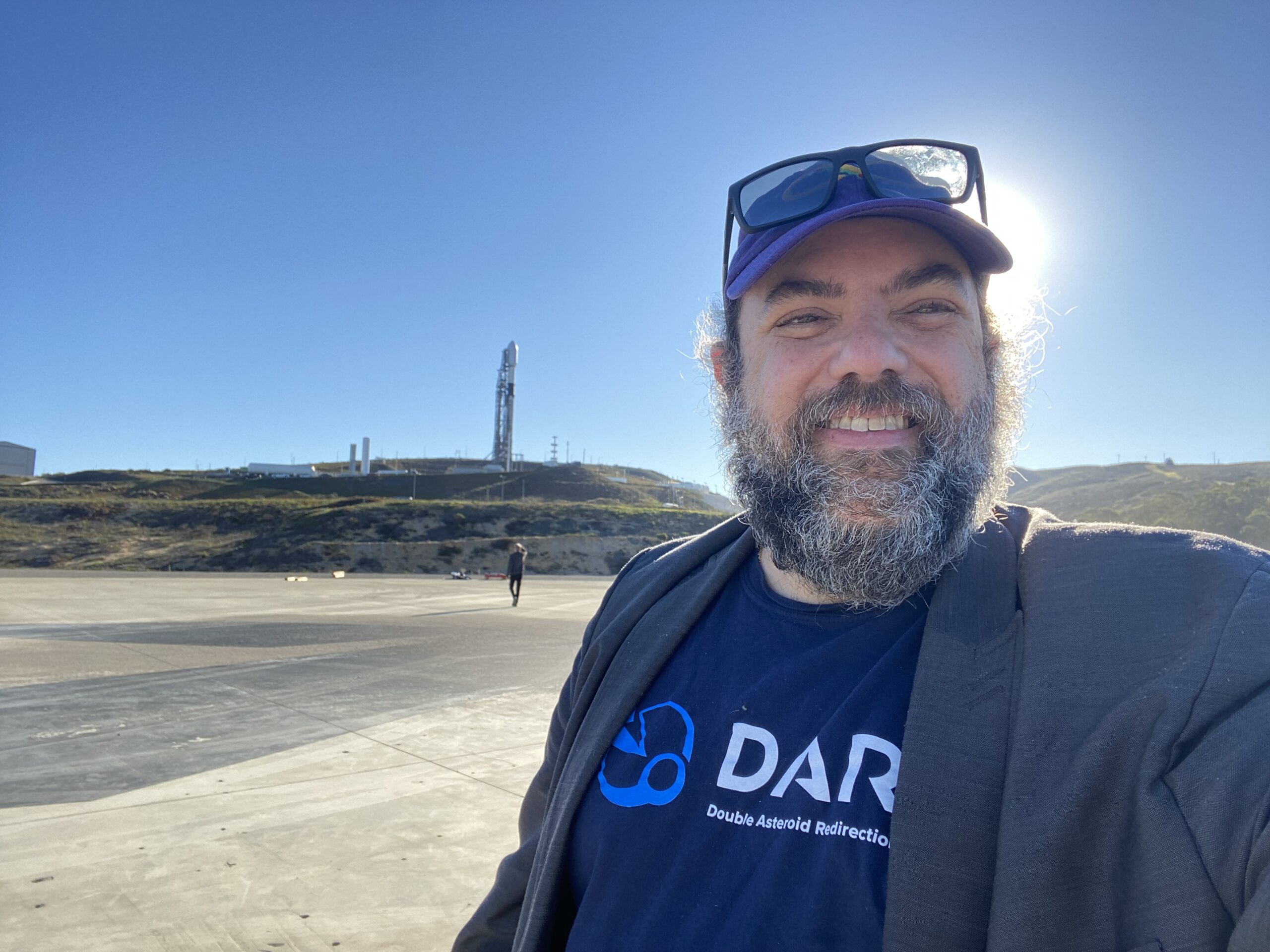
Andy Rivkin in front of the DART launch site. Photo: Andy Rivkin
“[Planetary defense] is kind of like smoke detectors in a house,” Rivkin says, after listing reasons that asteroids are cool and not just scary (they’re pieces of the nascent solar system that didn’t make it into planets. We will probably walk on them one day, and — despite ethical concerns — we might even be able to mine them for precious metals). “The payoff of knowing is really high.”
Carson Fuls agrees with both the enthusiasm and the optimism. “Asteroids are the only things out in space that you can actually hold in your hand,” he says, referring to meteorite fragments. And being hit by an asteroid is “the one natural disaster we can prevent.”
I ask Rivkin how he feels about asteroid apocalypse media. With a breath of laughter, he tells me he still hasn’t been able to watch Don’t Look Up. “It sounds like a three-hour-long stress dream for me.”
But apocalyptic stories of a civilization-ending asteroid are rapidly becoming as obsolete as Star Trek‘s flip phone communicators. DART showed us that we can nudge large asteroids off their collision course. As our detection protocols improve over the next decade, even the sneakiest mid-size asteroids will arrive with several days’ evacuation time. That’s no different from a wildfire.
“We have the technology to avert [asteroid] disaster,” says Ryan. “We still do not have the technology to stop a hurricane or an earthquake. We can’t stop a forest fire. But we can stop an asteroid impact. We are not going to be the dinosaurs.”

